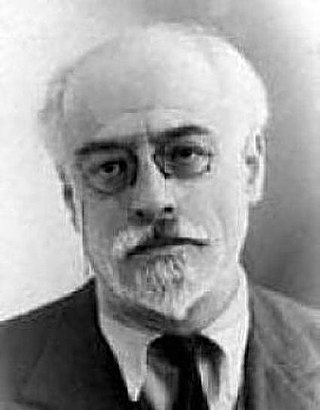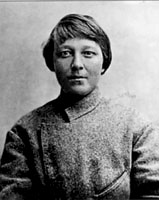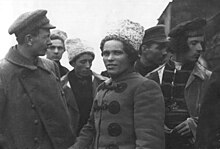
Peter Andreyevich Arshinov, was a Russian anarchist revolutionary and intellectual who chronicled the history of the Makhnovshchina.

Nestor Ivanovych Makhno, also known as Bat'ko Makhno, was a Ukrainian anarchist revolutionary and the commander of the Revolutionary Insurgent Army of Ukraine during the Ukrainian Civil War.

Vsevolod Mikhailovich Eikhenbaum, commonly known by his pseudonym Volin, was a Russian anarchist intellectual. He became involved in revolutionary socialist politics during the 1905 Russian Revolution, for which he was forced into exile, where he gravitated towards anarcho-syndicalism.

Maria Hryhorivna Nikiforova was a Ukrainian anarchist partisan leader that led the Black Guards during the Ukrainian War of Independence, becoming widely renowned as an atamansha. A self-described terrorist from the age of 16, she was imprisoned for her activities in Russia before managing to escape to western Europe. With the outbreak of World War I, she took up the defencist line and joined the French Foreign Legion on the Macedonian front before returning to Ukraine with the outbreak of the 1917 Revolution.
The Makhnovshchina was a mass movement to establish anarchist communism in southern and eastern Ukraine during the Ukrainian War of Independence of 1917–1921. Named after Nestor Makhno, the commander-in-chief of the Revolutionary Insurgent Army of Ukraine, its aim was to create a system of free soviets that would manage the transition towards a stateless and classless society.

Fedir Shchus, also Fyodor Shuss or Feodosiy Shchus, was a commander (ataman) in the Revolutionary Insurgent Army of Ukraine of Nestor Makhno.

Semen Mykytovych Karetnyk was a Ukrainian anarchist and a commander of the Revolutionary Insurgent Army of Ukraine (RIAU). He often replaced Nestor Makhno as supreme commander of the Black Army in 1920. Karetnyk gained a reputation for his central role in defeating the White Army in Crimea in November 1920.
The Nabat Confederation of Anarchist Organizations, better known simply as the Nabat, was a Ukrainian anarchist organization that came to prominence during the Ukrainian War of Independence. The organization, based in Kharkiv, had branches in all of Ukraine's major cities. Its constitution was designed to be appealing to each of the different anarchist schools of thought.

The Revolutionary Insurgent Army of Ukraine, also known as the Black Army or as Makhnovtsi, named after their leader Nestor Makhno, was an anarchist army formed largely of Ukrainian peasants and workers during the Russian Civil War of 1917–1922. They protected the operation of "free soviets" and libertarian communes by the Makhnovshchina, an attempt to form a stateless anarcho-communist society from 1918 to 1921 during the Ukrainian War of Independence.
The Battle of Peregonovka was a September 1919 military conflict in which the Revolutionary Insurgent Army of Ukraine defeated the Volunteer Army. After retreating west across Ukraine for four months and 600 kilometers, the Insurgent Army turned east and surprised the Volunteer Army. The Insurgent Army reclaimed its capital of Huliaipole within ten days.

Agafya "Halyna" Andriivna Kuzmenko was a Ukrainian teacher and anarchist revolutionary. After moving to southern Ukraine, she became a prominent figure within the ranks of the Makhnovshchina, a mass movement to establish a libertarian communist society. Kuzmenko spearheaded the movement's educational activities, promoted Ukrainization and acted as an outspoken advocate of women's rights. Along with her husband, the anarchist military leader Nestor Makhno, in 1921 she fled into exile from the political repression in Ukraine. While imprisoned for subversive activities in Poland, she gave birth to her daughter Elena Mikhnenko, whom she brought with her to Paris. Following the death of her husband, the outbreak of World War II saw her deportation for forced labour, first by the Nazis and then by the Soviets. After her release, she spent her final days with her daughter in Kazakhstan.

The Union of Poor Peasants, also known as the Peasant Group of Anarcho-Communists or the Huliaipole Anarchist Group, was an underground anarchist organization, operating in the years 1905–1908 in the Huliaipole Raion in Ukraine.

The Military Revolutionary Council was the de facto executive of the Makhnovshchina, empowered to act during the interim between sittings of the Regional Congresses.

The Regional Congresses of Peasants, Workers and Insurgents represented the "highest form of democratic authority" within the political system of the Makhnovshchina. They brought together delegates from the region's peasantry, industrial workers and insurgent soldiers, which would discuss the issues at hand and take their decisions back with them to local popular assemblies.
Oleksandr Kostyantynovich Semenyuta was a Ukrainian insurrectionary anarchist and leader of the Union of Poor Peasants.

Oleksiy Ivanovych Marchenko was a Ukrainian anarchist military leader, who fought in the war of independence as a cavalry commander in the Revolutionary Insurgent Army of Ukraine.
The Polonsky conspiracy, also known as the Polonsky plot or Polonsky affair, was an attempt by Ukrainian Bolsheviks to overthrow the Makhnovshchina during the autumn of 1919.

Foma Kozhyn was a Ukrainian revolutionary and the commander of the machine-gun regiment of the Revolutionary Insurgent Army of Ukraine.

The Starobilsk agreement was a 1920 political and military alliance between the Makhnovshchina, an anarchist mass movement led by Nestor Makhno's Insurgent Army, and the Ukrainian Soviet Socialist Republic, which the Bolsheviks had established as the legitimate government of Ukraine.
The Bolshevik–Makhnovist conflict was a period of political and military conflict between the Ukrainian Soviet Socialist Republic and the Makhnovshchina, for control over southern Ukraine. The Bolsheviks aimed to eliminate the Makhnovshchina and neutralise its peasant base. In turn, the Makhnovists fought against the implementation of the Red Terror and the policy of war communism.














